#contemporary take on traditional elements
Explore tagged Tumblr posts
Text

IG chairishco
#1/4 canopy bed#bedroom#contemporary take on traditional elements#mixed patterns#texture#interior design#creative
38 notes
·
View notes
Text
Sigil Magick: Illustrating Your Intent
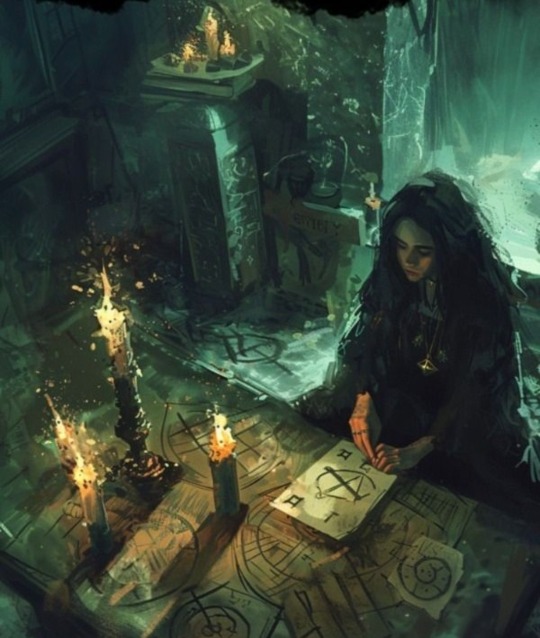
Sigils are a cornerstone of contemporary and chaos magick and function as keys to unlock the doors of reality and bend it to one’s will. These potent symbols serve as physical embodiments of one’s intentions, cast into existence through the fusion of art and willpower.
The crafting of a sigil begins with a clear and focused intention, which is then worked into a unique symbol through a creative magickal process. The magick practitioner inscribes deep personal meaning and style into their designs, making each unique to its artist. Sigils are ideal tools for manifesting your desires, imbuing objects with specific purpose and energy, protecting spaces, and communicating with the spirit world and should be used responsibly.
Origins
The practice of crafting sigils traces its roots to the ancient world but was modernized in the early 20th century by the works of Austin Osman Spare, an occultist and artist. He introduced the method of creating magical symbols by condensing letters of a desire into an abstract design. Aleister Crowley, too, influenced the practice by intertwining sigils with ceremonial magick, embedding them with a rich esoteric significance.
Some occult grimoires employ sigils as a means of contacting spirits, for example; Ars Goetia, The Book of Oberon, and Pseudomonarchia Daemonum.
Basics of Sigil Magick
Sigil magick emerges from the belief in one’s ability to manifest their focus into reality. Through a process of creation, a sigil becomes much more than mere ink on paper—it is the illustrated essence of desire. Individuals can use sigils as focal points for their will, empowering these symbols through meditation or ritual to enact change. The universe of sigils is vast and varied, types of sigils include:
• Pictorial Sigils: Intuitive symbols drawn from the subconscious
• Runic Sigils: Combinations of runic alphabets that resonate with specific energies
• Word Sigils: Derived from statements of intention, where letters are crafted into a unique symbol
Correspondences also serve a purpose in this class of magick, in order to help align one's intent to universal energies. As an artist crafts their sigil, they intertwine traditional symbols with personal significance, creating a bridge to the metaphysical world. Some relevant correspondences are:
• Numerology: Numbers carry vibrations that can enhance a sigil’s purpose.
• Zodiac Signs: Celestial influences infused to fine-tune the focus.
• Elements: The classic forces of Earth, Air, Fire, and Water lend their power to sigils, grounding them in natural harmony.
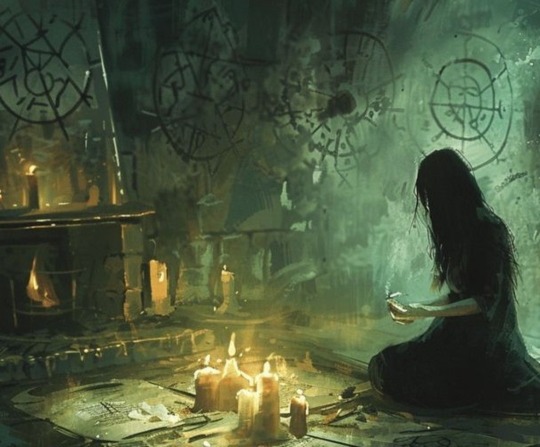
Sigil Creation
Before you take pen to paper, first envision your intent with clarity and purpose This may involve some deep introspection into the true nature of your desires. A precise intention lays the foundation for the sigil's power. Once ready, write out your intention and cross out any duplicate letters. From here a couple different methods can be utilized. Naturally you could always draw your sigils from pure instinct, creating spontaneous shapes to represent your intentions, but there are other techniques available.
The Wheel
This method employs a wheel to be used as a map for drawing your sigil. Simply start at the first letter of your intent and draw lines to each subsequent letter. Example:
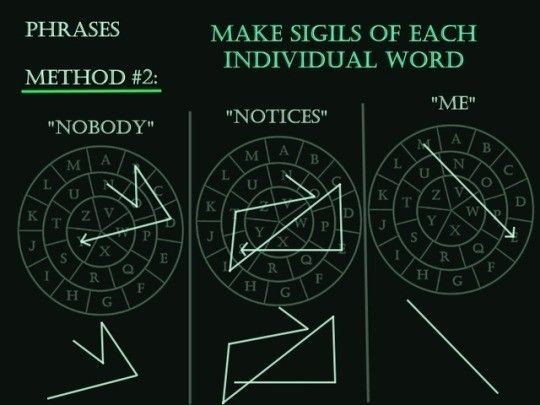
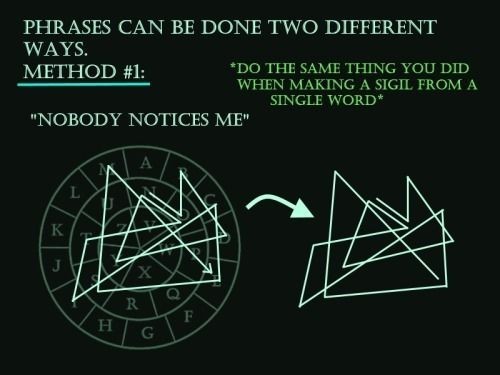
My Method
I make my sigils by breaking up the letters to create shapes. I will often decorate with extra shapes, symbols, and pictures as well. Here is a simplified example of my sigil creation process:

Next you must charge your sigil. Charging is the act of infusing the sigil with energy. The creator might enter a meditative state, focusing intently on the sigil while envisioning their intentions intertwining with the design. This act of focused concentration serves to embed the intention within the sigil, making it a beacon for the desired change.
Passive and Active Sigils
Intentioned sigils fall into either the passive or active sigil category based on how that sigil's energy is best utilized. Passive sigils are usually drawn on the body, item, or surface and then left alone to release their power over time. Active sigils involve some action to trigger the release of the sigil's energy, such as burning, burying, soaking with water/oil, and more. Some sigils can be used both passively and actively, but most will fall into one category.
Spirit Sigils
Many spirits and deities have sigils that represent them and these can be powerful catalysts for interacting with these beings. If the spirit you're working with doesn't have a sigil made for them (or even if they do) you can design your own symbol to connect with that spirit. Follow the same process, but instead of focusing on your intent, focus on the spirit/deity and connecting with it. You can even perform a ritual and provide an offering to invite the spirit into your space. This will allow you to draw divine inspiration straight from the source. Here are some examples of spirit/deity sigils, as well as some I created:
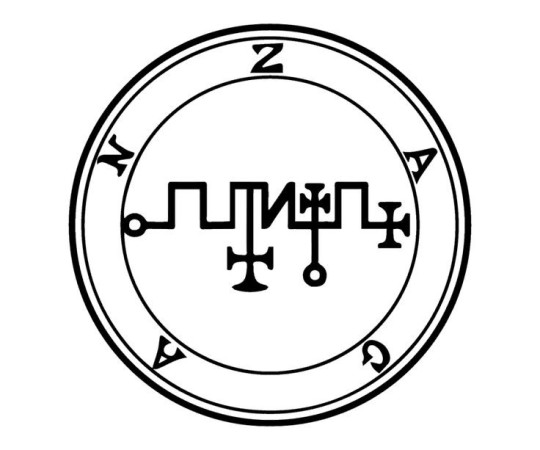
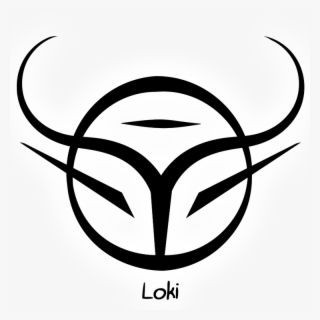

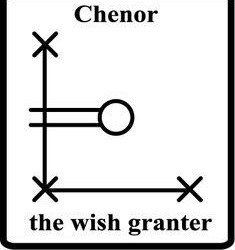
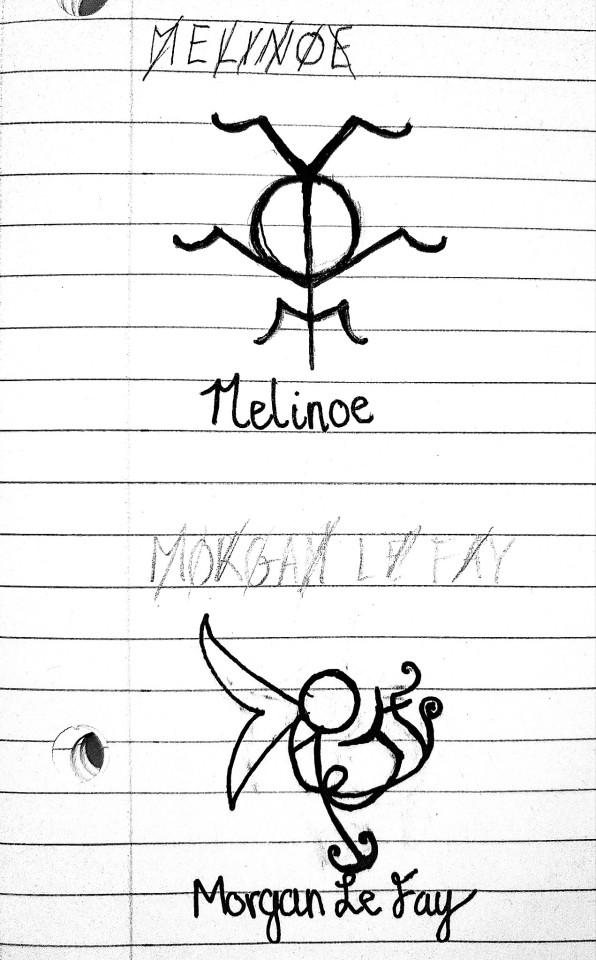
#magick#witch#witchcraft#sigil#sigils#sigil magic#sigil magick#chaos#chaos magick#chaos magic#chaos witch#satanic witch#lefthandpath#dark#satanism#demons#demonolatry#spirit work#spell work#spellwork#spell#spells#spellcasting#symbology#symbolism#symbols#eclectic#witchblr#witch community#pagan
478 notes
·
View notes
Text
I have thoughts on Jimin's SGMB
It's the gayest thing I've ever seen.
And by that I mean it's joyous, light-hearted, bright, and fun.
We can all agree, I think, that this is a happy and totally harmless song. Who could criticise Jimin for declaring his love in such a sweet and innocent way?
Of course not everyone will like it, and that's fine. You don't have to like everything he does - or everything BTS does - you are an individual with thoughts and feelings of your own - I hope. But putting that aside you'd have to be a troubled person indeed to take offence at anything here.
So, it is definitely a fan song, right? Jimin is singing to his fans... isn't he?
Maybe.
But if it is (I and I'm not convinced) it's not just a fan song.
It's sweet, so sweet, but....
Maybe it's a little too sweet?
We know Jimin is CUTIE SEXY LOVELY and LOVELY LOVELY LOVELY, but let's be honest, he's also a grown man. And Army are not children (mostly). In fact we have had many many conversations about how ARMY are not children.
But this whole production is pushing the sweet and innocent barrow so hard that I can't help wanting to look underneath and behind and inside to see what's really going on because it's so sweet it's hurting my teeth.
Compare the sophistication and self awareness of FACE to the bouncy, bright and child-like song-and-dance in the SGMB music video. They are WORLDS apart and we were told very specifically that the albums were linked.
"Following his first solo album, “FACE,” where he sought to explore his true identity, “MUSE” documents his journey in search of the source of his inspiration." said the Weverse notification.
So what's really going on here?
What are you doing Jiminie?
And more importantly, why are you doing it?
You could call it a pageant, or a carnival, or a circus - with Jimin as the ringmaster.
But my view is:
This a pantomime. And it's very clever.
According to the Oxford Dictionary, a pantomime is "A dramatic entertainment, originating in Roman mime, in which performers express meaning through gestures accompanied by music." Yes, that describes it.
Merriam-Webster tells us "[A pantomime] is an ancient Roman dramatic performance featuring a solo dancer and a narrative chorus" That also makes sense.
Oxford also specified that it's a modern BRITISH tradition. "a theatrical entertainment, mainly for children, which involves music, topical jokes, and slapstick comedy." It's a perfect fit.
The British link is already there - Jimin clearly told us he's influenced by The Beatles' Sergeant Peppers Album. There's also the styling of his suit. The stovepipe pants, narrow tie, and fitted jacket are very 1960s (and 1980s) British pop.
There's something old-school about a pantomime. It harks back to childhood, and to the nostalgia of holidays. And the styling of the MV is in keeping with that nostalgic feel too - from the Mountain scene with the vintage film title, to the intertitles - or title cards , to the circular frame of the opening scene.
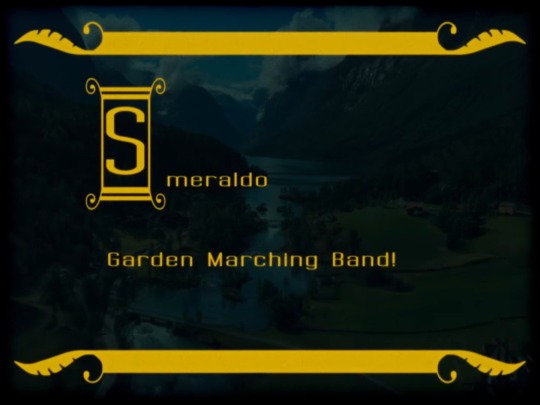
But back to the Pantomime itself...
A quick google search told me the following are important elements of pantomime. And we have most, if not all of them in this production.
Gender role reversal - TICK
Slapstick comedy - TICK
Colourful costumes - TICK
Audience participation - TICK (the children ARE the audience)
Exaggerated facial expressions - TICK
Take another look at the music video - it's all there.
Wikipedia tells us that pantomimes traditional told fairy tales or folk tales - often love stories - and that the primary role in a Pantomime was:
The 'Principal boy', a hero or charismatic rogue, traditionally played by a young woman in men's clothing.
Smart, very smart. With all the other conversations we've been having a round gender this is totally on the money.
Wikipedia goes on to say "Another pantomime tradition is to engage celebrity guest stars... Contemporary pantomime productions are often adapted to allow the star to showcase their well-known act.... If the star enters into the spirit of the entertainment, he or she likely adds to its overall effect"
Welcome, Loco.
(yes, I know collabs are de rigueur, but that doesn't change the fact that it fits - celeb guests are an established practice in Panto.)
So if this IS a Pantomime (and I'm not saying it definitely is but it looks like one to me), then it's intended to be a sung-story, told as much through dance and gestures as through words.
If it's a pantomime, what is it about?
I'm glad you asked! This little charade is the story of a young person called Jimin who is looking for love. He finds romance easily enough...
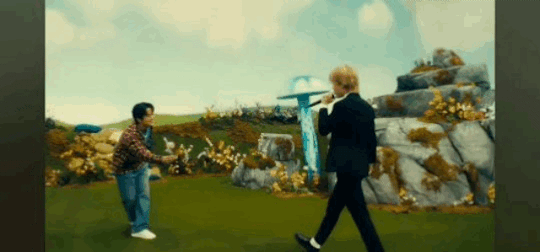
but real love takes a little longer.
Fortunately for our hero, he's brave (he will confess to his lover) and he is patient (he encourages them to do so too).
In between, there are shenanigans and goofing...

But our Charismatic Rogue is charming (if devilish) and wins the hearts of the audience - and his lover.
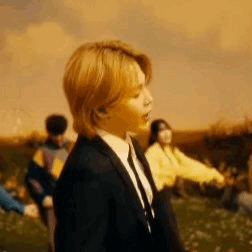
Let's take a closer look at how the story unfolds...
At the start of the MV, as the initial credits appear, Jimin is on stage vibing with his band. Loco is chilling on a rock like a lizard in the sun.
We get the ye olde intertitles, welcoming the audience and introducing.... SMERALDO Garden Marching Band
It's not Smeraldo Garden - Marching Band. It's Smeraldo *pause* Garden Marching Band. Smeraldo (secrets) has the emphasis.
After the intertitles, the scene opens on a group of children - they are ostensibly the audience of the band. They're playing paper-scissors-rock to see who will call for Jimin's attention.
The children run over to him and the tale begins.
Jimin, the main character of this story, immediately launches into song.
He starts off singing about Bangtan - mentioning their harmony (song and personal I think), he shows the Bangtan hand gesture we all know so well, and he sings "we gift happiness every day".
But he mentions June 12th.
Why June 12th?
Why not 13th, their debut day?
BECAUSE THIS IS NOT A SONG for ARMY. He's making it clear that at this point he's referring to Bangtan specifically, not the whole juggernaut of the fandom and fame. June 12th precedes ARMY.
He's made it clear from the start - this is NOT ABOUT ARMY.
Then he leans in and whispers to the children - and the camera -"lets talk about us".
Look at the kids' faces - they're miming shock. Ooooohhh! This is a big secret he's about to tell them - and us.
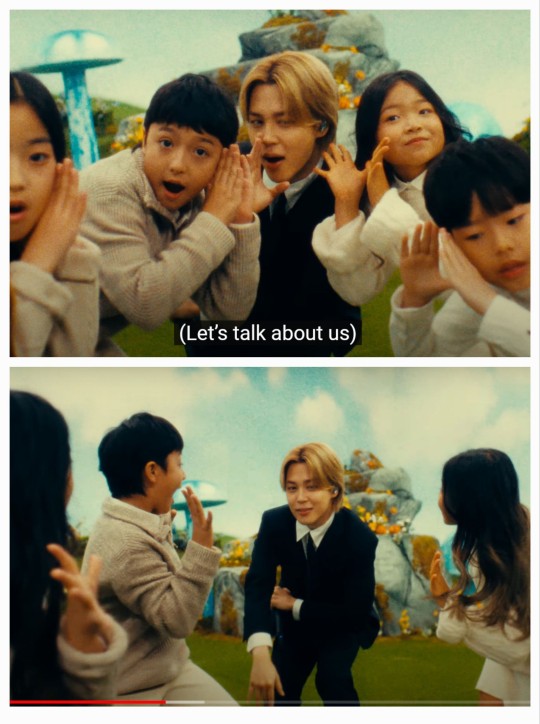
Look at Jimin's expression - he's just a tad smug. This is not a shocking secret to him, this is a fun secret.
Yes, he is indeed the charismatic rogue of this story.
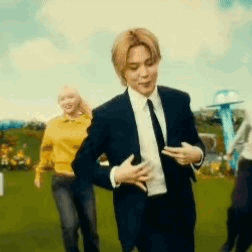
He sings:
"All the things we couldn't say before
And your hidden feelings too (just for you)
Don't you worry anymore
Since we're together now**
Let's be a little more honest."
So it seems our main character has a LOVER. Someone who couldn't be revealed and who hid their feelings.
<Wow, I have no idea who this could be...>
Hang on, what's happening in the MV??
On his journey, it seems our young hero has a few short-lived romances. And if you look carefully, they are all with men.
He accepts the rose from a man, and plants himself on the bench right up close to .... a man. He jumps up unperturbed, and gifts the rose to (you guessed it) another man.
Jimin manages to sidestep (or completely ignore) all the women except one, who he sends graciously into the arms of a random man before continuing on his journey.
Wait one moment... his romantic partners were ALL MEN??
ALL MEN??
ALL MEN?!!!!!
Yes darling, all men. Let's continue.
So, it seems none of Jimin's previous romances grew into anything more, but he takes his own advice with his mysterious lover and confesses first.
He smirks. He flicks his jacket with pizzazz. He's ready.
He sings:
"Ooooh I love you babe,
I'll come closer to you
I want to hold your hand,
I want you babe (yessir)
Please note the hand gesture in this choreo - it's another one we've seen many times.

The dance ends and Jimin scans the surroundings and spots his old friend...
[Enter stage left: Loco]
Oh look, the friend is a rapper a few years older than Jimin. They seem to have a lot of fun together, Jimin and his rapper friend. There are ZERO romantic overtones here. This guy happily goes along with all the goofing and silliness even though he looks a tiny bit mortified. Either they are both very good actors, or a lot of the time, Loco was holding in his laughter. And Jimin seems incredibly amused by that.
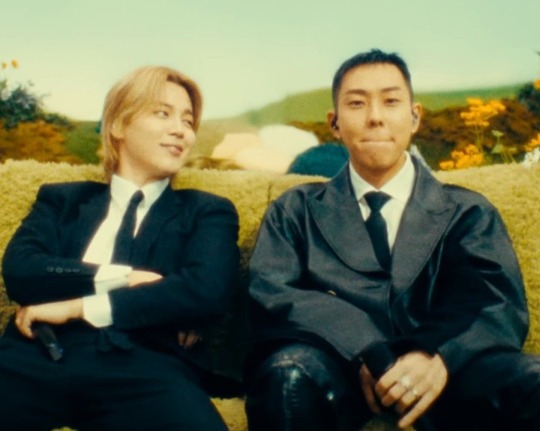
They hang out together until.... something in the atmosphere changes:
The colours become richer, light become warmer, and oh look....
It's *The Golden Hour*
I AM NOT MAKING THIS UP, PEOPLE. HE REALLY DID THIS.
Jimin leaves Loco, chasing the golden light as he sings about "the dazzling sky." Golden confetti (champagne, anyone?) falls all around him and then ...
fucking sunflowers bloom.
SUN FLOWERS.
BLOOM.
FOR HIM.

<I need to lie down and process this>
SUNflowers...
Remind me again what sunflowers are known for? Oh yes, they are symbolic of the sun. Guess what else? They turn to face the sun.
Yup, the sunflowers all turn their faces toward the camera. I'm not crazy, okay?! I'm not.
SMH... let's move on.
Jimin re-joins his band, and the sunflowers do their sunflower thing, and Jimin sings:
"So tell me how you feel,
let whatever you feel
wash over you"
Then he sings
"I love you babe, (yessir)
I'll come closer to you
I want to hold your hand,
I want you babe (yessir)
Please note the hand gesture again
👉 👈
The bridge is next, and Jimin takes us back to Bangtan. As all the stars appear (that ocean of purple light that surrounds them at concerts) and everyone takes their place on stage, they turn up the music. <Are my eyes watering? Perhaps>
"I think we're ready now
<NGL I may have shed a tear here>
Lets begin 1, 2
<Ok fuck, I bawled at this point. Goddammit Jimin!>
Put your hands up"
*cute wiggle-dance commences* and Jimin spots his good friend the rapper again, hiding on the sidelines. He pulls him into the chorus line and they do more silliness and everyone is having a great time.
Confetti- flower petals fall, there's laughter and happiness all around, and they bow and bid us good bye.
The show is over.
*THE END*
But wait, I am not done.
A few more things bear mentioning here:
I saw quite a few comments saying this song is for ARMY.
It is categorically NOT for ARMY. Besides the fact that we already have Closer Than This - a fan song - on this album, Jimin specifically chose a date before debut - before ARMY existed - to place in this song. No mention of ARMY at all. Accept it graciously, this is not for you.
I wanna hold your hand
This lyric is a reference not only to the Beatles song "I Want to Hold Your Hand", It's also a common theme with Jimin and Jungkook. We see them finding any feeble excuse to hold hands, shake hands, touch hands. Yes, we see you two...
I am you, You are me
The gesture used in the choreo when Jimin is singing his confession - I failed miserably to catch it in my screengrab but there's no doubt it's their "I am you, You are me" gesture. Take a look for yourself.
All Jimin's romantic moments happened with men.
I'm not saying in his life, I am saying in this MV. All of them. The only interaction he has with a woman is one brief moment where he grabs her wrist as she passes by and he swings her into the path of a guy behind him. He even scoots around the women and sidesteps them. That can't be accidental. He's making a point.
The addition of 'yessir' in the lyrics makes it clear that he's confessing to a man.
I cannot see any reasonable way to refute this. The BH subtitles include it even though you have to listen carefully to catch it. THAT IS A CHOICE, NOT AN ACCIDENT.
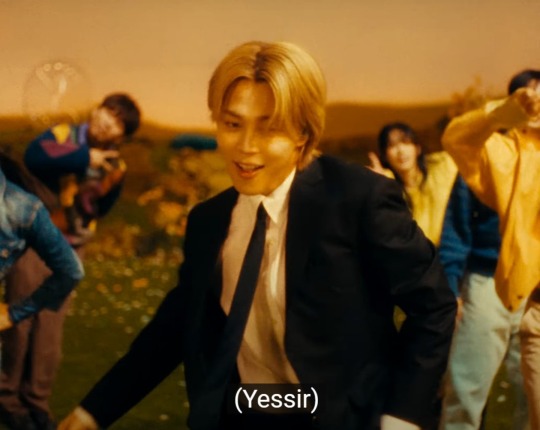
"Even though we're together now"
These lyrics could mean theyre an established, committed couple. But if we think a little broader than that, and a little more literally, who is he together with right now?
It's strategically brilliant.
This is his 'tell all expose' but he has built in a rock solid escape clause by using the panto format. Staging the whole love story - including the prior boyfriends and the man he's now in love with - as an over the top comedy show makes it easily dismissible as pure fiction. By including the fantasy/magical elements he just makes it more so. Deniers will be able to come up with a dozen reasons to reject this... 'It's a fantasy story', 'not all songs are autobiographical', 'he's making a point', 'he's raising LGBTQIA+ awareness'... all true maybe, but that doesn't change the fact that this is HIS song, about HIS muse. If you've been paying attention (and even if you haven't) you will know this is certainly not pure fiction.
AND FINALLY....
The most important one, I left till last. I actually want to scream this, in all caps, in the biggest font possible. But I will restrain myself.
The song is bookended by references to BTS.
That is hugely important. For those who may not be aware, this is a literary device. Bookending a story provides a start and end reference point. Here, the Bangtan bookends provide context for the rest of the lyrics - they frame the lyrics within them. That means the events happening in the song, happen within the context of Bangtan. Reading between the lines, the person he is singing to/about is within Bangtan.
This is not reaching. This is like mixing blue paint and yellow paint together. You will get green paint.
💛+💙=💚
So yes, this song is the gayest thing I've ever seen.
And I DO mean it's joyous, light-hearted, bright, and fun.
But yes, it's also absolutely and totally really really GAY
🏳️🌈🐥🦄🌈🏳️⚧️🌻🐰☀️🏳️🌈
Thank you Jiminie
#park jimin#jeon jungguk#jikook#kookmin#국민#true love#jungkook#bts jimin#jimin comeback#jimin sgmb#smeraldo garden marching band
510 notes
·
View notes
Note
Hi there, I’m planning on writing gothic/gothic romance fiction. Do you have any tips?
Do you also have any tips to not make your writing too repetitive? I have a habit of repeating words a lot.
Writing Notes: Gothic Fiction
Gothic Novel
European Romantic pseudomedieval fiction having a prevailing atmosphere of mystery and terror.
Its heyday was the 1790s, but it underwent frequent revivals in subsequent centuries.
Called Gothic because its imaginative impulse was drawn from medieval buildings and ruins, such novels commonly used settings such as castles or monasteries equipped with subterranean passages, dark battlements, hidden panels, and trapdoors.
The Gothic is characterized by its darkly picturesque scenery and its eerie stories of the macabre.
It draws its name and aesthetic inspiration from the Gothic architectural style of the Middle Ages — crumbling castles, isolated aristocratic estates, and spaces of decrepitude are familiar settings within the genre.
Gothic fiction is rooted in blending the old with the new.
As such, it often takes place during moments of historical transition, from the end of the medieval era to the beginnings of industrialization.
Contemporary technology and science are set alongside ancient backdrops, and this strange pairing helps create the pervasive sense of uncanniness and estrangement that the Gothic is known for.
Past & present fold in on each other; even as man’s technological advancements seem to make him increasingly powerful, history continues to haunt.
Elements of Gothic Literature
The Gothic is a genre of spiritual uncertainty: it creates encounters with the sublime and constantly explores events beyond explanation. Whether they feature supernatural phenomena or focus on the psychological torment of the protagonists, Gothic works terrify by showing readers the evils that inhabit our world.
CHARACTERS
Characters in Gothic fiction often find themselves in unfamiliar places, as they — and the readers — leave the safe world they knew behind.
Ghosts are right at home in the genre, where they’re used to explore themes of entrapment and isolation, while omens, curses, and superstitions add a further air of mystery.
ATMOSPHERE
Eeriness is as important as the scariness of the events themselves.
In a Gothic novel, the sky seems perpetually dark and stormy, the air filled with an unshakable chill.
THEMES
In addition to exploring spooky spaces, Gothic literature ventures into the dark recesses of the mind: the genre frequently confronts existential themes of madness, morality, and man pitted against God or nature.
Physical and mental ruin go hand in hand — as the ancient settings decay so do the characters’ grips on reality.
History of Gothic Literature
The vogue was initiated in England by Horace Walpole’s immensely successful The Castle of Otranto (1765).
His most respectable follower was Ann Radcliffe, whose The Mysteries of Udolpho (1794) and The Italian (1797) are among the best examples of the genre.
A more sensational type of Gothic romance exploiting horror and violence flourished in Germany and was introduced to England by Matthew Gregory Lewis with The Monk (1796).
The classic horror stories Frankenstein (1818), by Mary Wollstonecraft Shelley, and Dracula (1897), by Bram Stoker, are in the Gothic tradition but introduce the existential nature of humankind as its definitive mystery and terror.
Easy targets for satire, the early Gothic romances died of their own extravagances of plot.
But Gothic atmospheric machinery continued to haunt the fiction of such major writers as:
Charlotte, Anne, and Emily Brontë, Edgar Allan Poe, Nathaniel Hawthorne, and even Charles Dickens in Bleak House and Great Expectations.
In the second half of the 20th century, the term was applied to paperback romances having the same kind of themes and trappings similar to the originals.
Tips on Writing Gothic Fiction
SETTING
Gothic fiction can, of course, be set anywhere – but 2 key components of Gothic settings are as follows:
Gothic settings are isolated – a small community, a rural town, a single-family home on the open moors… wherever your Gothic story takes place, make sure that the setting is in isolation from the rest of the world. Places that are difficult to get to, with small populations, or are only home to one family or small group of people are ideal for weaving a Gothic tale. Even if your characters are not physically isolated – maybe they live in a city, for example – their isolation should be present in some way; maybe emotionally, maybe socially. There are plenty of options therein.
Gothic settings revolve around a home base – not necessarily a home or house, though that is quite common; but, with almost every Gothic tale, a central setting is introduced very quickly and almost all the action takes place inside or around it. This furthers that feeling of isolation, and also helps the house or laboratory or island or whatever else feel alive, as if it is a character itself.
These settings are often fun to develop and aid the story so, so much by being atmospheric and anthropomorphic.
By creating a strong setting and central location, you are setting up your Gothic fiction for success.
VOICE & CHARACTER
A strong voice, usually in first person, is a staple of Gothic fiction.
Gothic main characters are usually curious, determined, and unable to rest until whatever is going on around them is uncovered.
They are not faint of heart and often have experience dealing with hardship in the past; they are uniquely qualified for whatever disturbing events are going on.
Your character’s voice should be curious, but not paranoid; apprehensive, but not frightened or cowardly; and, above all, interesting.
As many Gothic are written in first person, you want your main character to take action and investigating the goings-on.
ATMOSPHERE
Similar to setting, it’s important to focus on atmosphere. Make sure you appeal to the five senses – let your reader know how it sounds, smells, feels!
The more details, the better; immerse your reader by making them feel as if they are actually in the space.
Often, as mentioned, Gothic novels take place in areas that are remote, experience frequent storms or bad weather, or otherwise have a very ominous environment.
Of course, Gothic novels can take place anywhere, but the takeaway here is to remember to highlight aspects that go beyond the visual.
SUBGENRE
Know what the genre within your Gothic work is or is going to be.
Are you writing a Gothic romance? A Gothic thriller? A Gothic horror? There are even types of books one might categorize as a “cozy Gothic” – taking the elements of a cozy mystery, but with a Gothic setting and characters.
There are some very specific geographical locations and time periods for Gothics, Victorian or Regency-era Northern England being a couple of them; but they are not all set in Europe in the 19th century, nor should they be.
Consider such settings as seen in Southern Gothic in the 2020s, for example, or Canadian Gothic (set anywhere in Canada, but usually southern and rural Ontario) in the late 90s, among many others. These are only a few examples of hundreds!
Dark academia titles can often fall into the Gothic genre as well, and, of course there are Gothic fantasy and sci-fi titles as well.
Carefully consider what sub-genre your Gothic fiction falls under before writing it, or during the early stages of writing as your work gets fleshed out. It may fall under just one category, or multiple! Either way, knowing this will help you write and later market your title.
MARKETING
Think about marketing at an early stage. Make it clear that it is a Gothic novel!
And consider publishing your title at a time when the Gothic genre might be in higher demand, such as during the month of October or the winter in general.
Appeal to fans of grim stories, horror romance, and what have you by theming your marketing.
If writing a Gothic novel is new for you, be sure to highlight that!
It can be exciting when an author tries out a new genre and moves into a new literary space. Be sure to let your readers know of this new venture.
Gothic Romance
As a genre, gothic fiction was first established with the publication of Horace Walpole’s The Castle of Otranto in 1764. Characterized by a dark, foreboding atmosphere and outlandish, sometimes grotesque, characters and events, gothic fiction has flourished and branched off into many different subgenres in the centuries since its creation.
While Walpole introduced what would later become the definitive tropes of the genre (creepy castles, cursed families, gloomy atmosphere), it was not until Ann Radcliffe’s A Sicilian Romance in 1790 that gothic romance began to develop as its own legitimate subgenre.
Radcliffe kept many of the same tropes established by Walpole’s work, such as isolated settings with semi-supernatural phenomena; however, her novels featured female protagonists battling through terrifying ordeals while struggling to be with their true loves.
This concept is what separates gothic romance from its cousin, gothic horror.
Female leads would come to dominate gothic romance, especially after the publication of Charlotte Brontë’s Jane Eyre in 1847.
A young woman struggling to maintain her independence as she falls for a dark, brooding, handsome man became a genre-defining plot of gothic romances published in the decades that followed.
A renewed public interest in gothic romance came on the heels of Daphne Du Maurier’s Rebecca upon its publication in 1938.
Authors such as Victoria Holt, Mary Stewart, and Phyllis A. Whitney dominated the gothic romance trade paperback market from the 1960s to the 1990s.
The image of a young woman running away from a darkened castle became a staple of gothic romance novel covers.
In 1983, Gaywyck, by Vincent Virga, became the first published gay gothic romance.
Modern additions to the genre continue to reflect its interest in both terror and romance, while also delivering updated or reimagined versions of familiar tropes.
Tips for Avoiding Word Repetition
While repeating a word or phrase can add emphasis and rhythm to your writing, it can also make your writing awkward and difficult to read. When you’re not using repetition as a rhetorical device, repeating words can get in the way of good writing. Here are some tricks for avoiding unnecessary repetition of words:
Read your work aloud. Reading aloud will help you avoid unintentional word repetition. Reading your work aloud is an excellent way to both hear the sonic effects of your prose and catch awkward repeated sounds or other unintended effects.
Read your work backward. Reading your work backward is an editing trick that forces your brain to slow down and pay close attention to the individual sentences. Start at the end of a chapter, paragraph, or page and read the last sentence of that section. (Don’t read the sentence itself backward—it won’t make any sense.) Next, read the second-to-last sentence, and so on. This will allow you to work at the sentence level, catching any unintended repetition or other small mistakes that your brain naturally skims over.
Consult a thesaurus. So you’ve found a repeated word. Now what? You can try rearranging your sentence to get rid of the repeated word, or you can keep the sentence the same and plug in a different word in its place. If you’re at a loss, consult a thesaurus for a list of synonyms. You want your writing to sound like you, and to be accessible to your audience, so it’s best to avoid using words you aren’t familiar with. But if you find yourself unintentionally repeating the same word over and over, a thesaurus can help you identify another word that more precisely captures your meaning.
Some Writing Strategies to Avoid Repetition
Excerpts from writing tips on repetition by Dr. Ryan Shirey:
While repetition is not an inherently bad thing (and can quite often be used to great effect as in the classical rhetorical technique of anaphora), most of us want to make sure that we’re not boring our readers by saying the same things over and over again without any variation or development.
If you’re worried about repeating ideas, then one of the easiest and most illuminating things that you can do is to reverse outline your draft. When you reverse outline, you take your draft and distill each idea and piece of evidence back into an outline. Some writers like to do this in the margins and others prefer a separate sheet of paper. Whatever your preference, a reverse outline will let you see rather clearly whether or not you’ve returned to the same idea or piece of evidence multiple times in the same essay. If you find that you have, you can think about rearranging or cutting paragraphs as necessary.
Another strategy if you’re worried about repeating ideas is to use different colored highlighters, colored pencils, or coloring tools in a word processing program to mark areas of your text where you’re working on specific ideas. If I’m writing a paper on the history of the run up to World War I, for example, I might decide to mark all the areas where I discuss treaty arrangements in green, all the areas where I discuss colonial expansion in blue, the parts that discuss arms manufacturing and trade in red, and so on. Once I’ve visualized these ideas with color, I can see more easily whether or not I keep returning to the same topics or whether I need to restructure any portions of my essay. Be careful, though–you don’t want to create artificial distinctions that might negatively impact your overall point. For instance, if a conflict over colonial expansion leads to a treaty arrangement, I would need to be very careful about using the context in which I’m discussing that treaty dictate how I code that sentence or paragraph.
If you’re worried about repeating words or phrases, you can use the “find” feature in your word processing program to highlight all of the instances where you’ve used it. Once you’ve identified the problem areas, you can look for ways to combine sentences using coordination or subordination, replace nouns with pronouns, or (very carefully) use a thesaurus to diversify your vocabulary.
Sources: 1 2 3 4 5 6 ⚜ More: Writing Notes & References
Hope this helps with your writing!
#anonymous#gothic#writeblr#literature#dark academia#writers on tumblr#writing tips#writing advice#on writing#writing reference#spilled ink#writing prompt#creative writing#romance#writing resources
131 notes
·
View notes
Text
Types of Dates
That The JJK Men Would Take You In

Pairings: JJK Men x Reader
Inc: Satoru, Suguru, Kento, Choso, Toji
Cont: Fluff, not proofread
Minors DNI

Satoru: Amusement Park Date
Satoru would be the perfect date to take you on all the thrill rides at the park. He'd probably try to win every carnival game just to impress you and show off his skills. He'd spoil you with snacks and treats throughout the day, insisting that nothing is too sweet or unhealthy. Satoru would likely try to set up some sort of romantic moment on a scenic ferris wheel ride.
Suguru: Stargazing Date
Suguru would choose a secluded and peaceful location, far away from the city lights, to ensure the clearest view of the stars. He would likely prepare a picnic with some snacks and drinks to make the experience even more enjoyable. He would be an avid skywatcher and point out various constellations and planets, sharing his knowledge with you. Suguru would probably bring a cozy blanket to keep you warm and comfortable during the chilly night.
Kento: Art Gallery Date
Kento would be a patient and thoughtful companion, taking the time to thoughtfully analyze each piece of art and share his insights with you. He would likely appreciate the more traditional or classical pieces, but would also be open to contemporary or abstract art. During the date, Kento would occasionally point out specific details or hidden meanings in the artworks, showcasing his observant and analytical nature. He may surprise you by buying a small artwork as a souvenir to remember the date.
Choso: Movie Date
Choso would be a loyal and attentive companion, making sure to focus on the movie. He would likely enjoy action or adventure movies, but could also be open to other genres such as comedies or dramas. During the movie, he might lean in close to you, taking in the scent of your hair or skin. Choso may occasionally whisper commentary or ask questions about the movie, but would still be invested in the plotline.
Toji: Hiking Date
Toji would likely be an expert hiker, knowing all the best trails and routes to take. He would probably want to challenge you with a more difficult or strenuous hike to see how far you can push yourself. Toji would probably challenge you to race to see who can reach the peak first, adding an element of playful competition to the date. During the hike, he may tease or make lighthearted jokes at your expense.
#୧ ׅ𖥔 ۫ Ro's Headcanons⋄ 𓍯#jjk headcanons#jjk x you#jjk fandom#jjk x reader#jujutsu kaisen x you#jjk fanfiction#jjk smut#jjk fluff#gojo satoru#satoru gojo#jjk satoru#gojo x reader#satoru gojo x reader#satoru x reader#geto#geto suguru#suguru geto#jjk suguru#suguru x reader#geto x reader#suguru geto x reader#nanami kento#kento nanami#jjk nanami#nanami x reader#kento x reader#nanami kento x reader#choso#choso kamo
137 notes
·
View notes
Photo
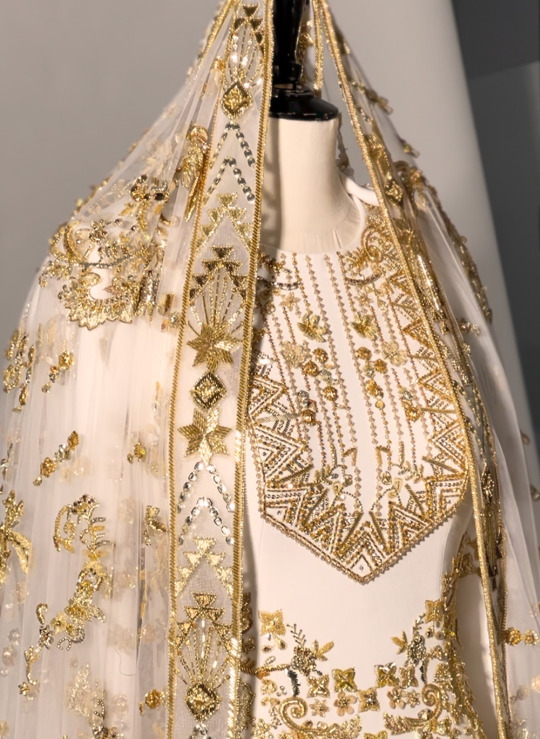
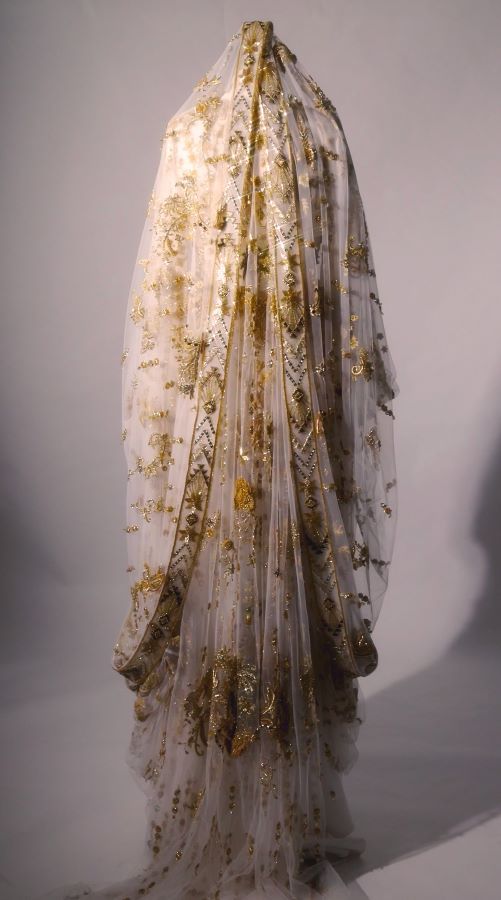
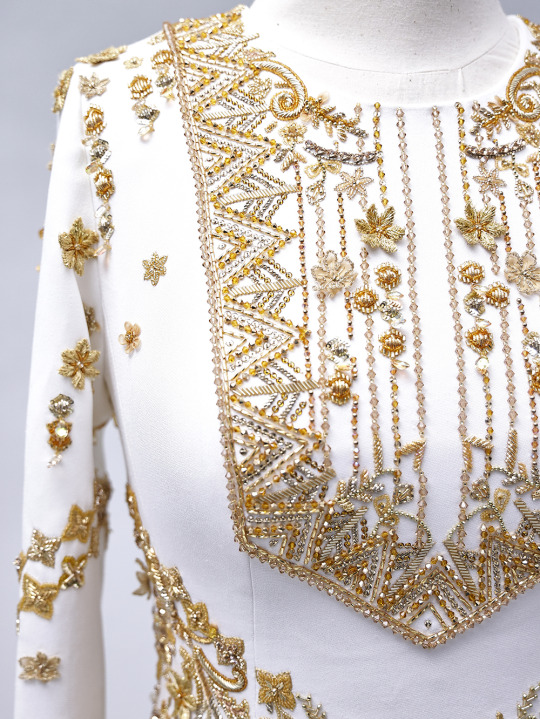

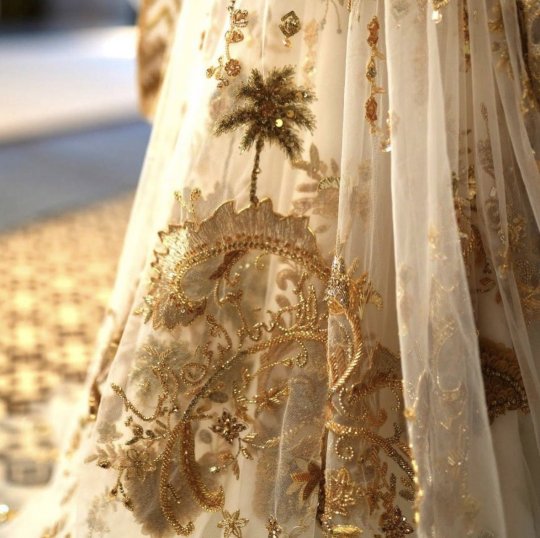
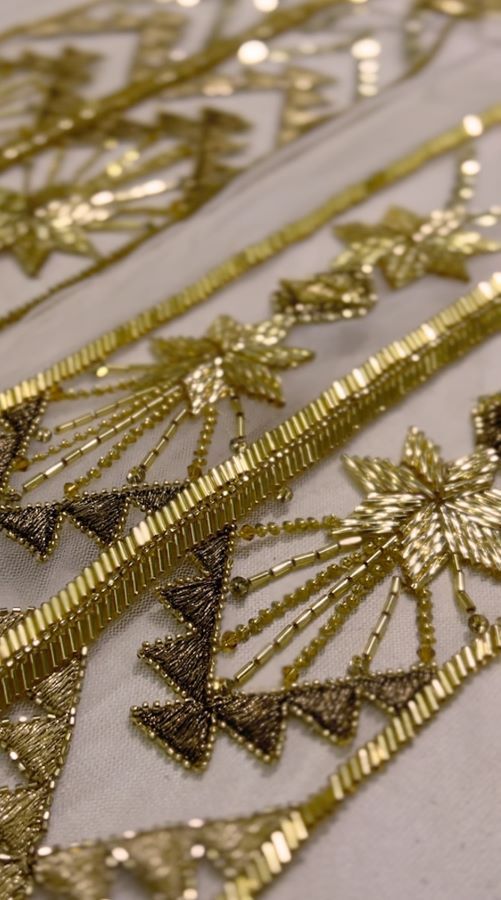
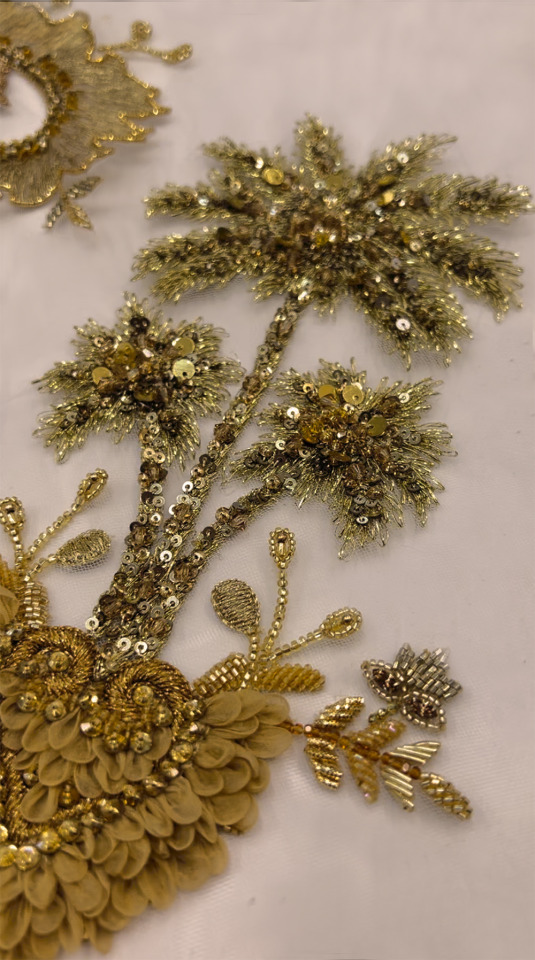



Close-up of Rajwa Al Saif's henna party outfit on 22 May 2023. The dress, by Saudi designer Honayda Serafi, took more than 2,000 hours to create, and includes several hidden messages of love, Vogue Arabia reports.
“Crafted by Saudi designer Honayda Serafi, Al-Saif’s henna dress is a vision in white and gold. The future queen of Jordan celebrated with family and friends in a look that takes inspiration from the traditional Najdi dress, known as Sahabi thoub, which originates from the Najd region of the Kingdom of Saudi Arabia. Keeping in mind the occasion and the family, Serafi made sure to combine the cultural beauty of the Hashemite kingdom of Jordan and the Kingdom of Saudi Arabia to celebrate the union of Rajwa and Prince Hussein beautifully.
Featuring a handcrafted veil and dress, Rajwa Al-Saif’s pristine white henna outfit comes doused in 3D ornaments, made using a mix of silk, metallic threads and traditional reed strings (a signature element of Najdi embroidery). To create this masterpiece, Honayda Serafi took cues from the bride’s personality, attempting to reflect her innate grace, the rich traditions of her land, and her contemporary spirit.
Look closely, and you’ll notice that Al-Saif’s gown is replete with lovingly made details. Featuring a high round neck and full sleeves, the crepe gown features an inverted triangle-shaped bodice that is inspired by the traditional Najdi bodice design, normally worn as a separate piece. As the body-skimming gown continues, it flares out towards the ankles to create a mermaid-esque shape. The bodice of the gown is elevated using embroidery: soft organza flowers share space with geometric shapes and Arabic motifs, all of which are typical to Saudi Arabia and reflect the beauty and traditions of the bride’s homeland.
Rajwa Al-Saif’s veil has also been embroidered with meaningful designs, making this piece so personal to her journey. Seven Jordanian stars adorn her veil to signify the seven-pointed star that sits proudly on the Jordanian flag. What makes this symbol even more special is its religious meaning: The star on the Jordan flag signifies the seven verses in the opening chapter of the Holy Qur’an, and the seven mountains of Amman.
Along with the stars, the veil also features intricate palm trees as a reference to Saudi Arabia, and even some poetry. The words “I see you, and life becomes more beautiful” have been embroidered into Al-Saif’s veil, from Tunisian poet Abu al-Qasim al-Shabi, known for his Andalusian notes. If you’re a fan of Rajwa Al-Saif’s elegant wardrobe, you may already know that the bride-to-be has a soft spot for special symbols when it comes to her clothing. Back in August 2022, when Rajwa was officially engaged to Prince Hussein, she also commemorated the occasion with her clothing���an abaya that was embroidered with two gold birds, symbolizing two souls in love.”
The veil took 760 hours to complete
An exquisite piece of couture requires hours of effort, and Rajwa Al-Saif’s henna outfit is no different. According to the designer, Al-Saif’s veil took 760 hours to complete, and was worked on by a team of experts, craftsman and women. Extending to 10 meters, the piece was made using handcrafted tulle, a process that normally takes close to 2,000 hours of work. As for her billowing gown, the creation is the result of 340 hours of work.
Honayda Serafi: “I am very proud and honored to be part of this historic union”
Speaking on the occasion, Serafi shared, “I am very proud and honored to be part of this historic union between His Royal Highness, Crown Prince Al Hussein bin Abdullah II of the honorable Hashemite family, and Miss Rajwa Khalid Alseif. May they be blessed with happiness and their union be crowned with success.” (x)
808 notes
·
View notes
Text
The Philosophy of Satanism
The philosophy of Satanism, particularly in modern interpretations, is often grounded in individualism, self-empowerment, and a rejection of traditional religious dogma. There are various branches of Satanism, each with its own approach and interpretation. While early portrayals in history associated Satanism with anti-Christian and occultist ideas, contemporary movements largely emphasize philosophical, symbolic, and sometimes atheistic elements.
Core Branches of Satanism
LaVeyan Satanism: Founded by Anton LaVey in 1966, LaVeyan Satanism is one of the most well-known and structured forms. LaVey’s Satanic Bible outlines Satanism as an atheistic philosophy that emphasizes rational self-interest, individuality, and personal freedom. LaVeyan Satanism doesn’t worship a literal Satan but uses "Satan" as a symbol of rebellion against conformity, self-denial, and oppressive moral codes. Core principles include self-reliance, pursuit of pleasure, and rejection of guilt or shame for natural human desires.
Theistic Satanism: In contrast to LaVeyan Satanism, theistic Satanism involves the belief in and veneration of Satan as a deity or supernatural being. Followers may view Satan as a force representing wisdom, self-empowerment, or the spirit of rebellion against unjust authority. They typically emphasize spirituality, ritual, and a personalized relationship with their deity.
The Satanic Temple: Founded in 2013, The Satanic Temple is a non-theistic, socio-political organization that advocates for secularism, religious freedom, and separation of church and state. Its use of Satanic imagery and symbolism is often satirical, serving as a critique of authoritarianism, religious fundamentalism, and hypocrisy. The Satanic Temple’s guiding principles prioritize compassion, rational inquiry, and individual sovereignty.
Other Forms of Satanic Philosophy: Other branches, including Luciferianism, focus on the figure of Lucifer as a symbol of enlightenment, knowledge, and self-discovery. Unlike traditional Satanic archetypes, Luciferianism often associates Lucifer with wisdom, learning, and the search for truth.
Key Philosophical Concepts in Satanism
Individualism and Self-Empowerment: Many forms of Satanism prioritize the individual as the center of moral authority, encouraging followers to take personal responsibility and to live according to their own principles and desires. Self-reliance and self-empowerment are celebrated, often rejecting dependence on external authority for moral guidance.
Rebellion and Nonconformity: Satanism often embraces the symbol of Satan as a figure of rebellion against oppressive norms or restrictive moral frameworks. This aspect resonates with the desire for freedom from traditional dogmas and the encouragement to think critically and independently.
Pleasure and Self-Interest: Satanism frequently rejects asceticism and self-denial, advocating for the pursuit of pleasure, self-gratification, and enjoyment of life. This philosophy is rooted in a materialist understanding of existence, where one’s current life is seen as the primary focus rather than preparation for an afterlife.
Critical Thinking and Skepticism: Modern Satanism, especially within The Satanic Temple, emphasizes scientific skepticism and rationalism. It challenges superstitions, encourages questioning, and critiques traditional religious dogmas that demand faith without evidence.
Ethics and Morality: Satanic philosophies often propose alternative ethics rooted in individual responsibility rather than divine commands. LaVeyan Satanism’s “Nine Satanic Statements,” for instance, outline an ethos that prioritizes self-respect, personal boundaries, and retributive justice, but they reject traditional moral frameworks as rigid or unnatural.
Satanism in Cultural and Social Context
Satanism’s popularity and influence are, in part, responses to societal structures, particularly within heavily religious cultures. By challenging the norms, it presents a counterpoint to dominant religious narratives, emphasizing secularism and religious pluralism.
In modern contexts, Satanism also serves as a vehicle for social critique and protest. Organizations like The Satanic Temple advocate for political issues like freedom of expression and the separation of church and state, often using provocative imagery to challenge established social orders and protect minority rights.
Controversies and Misconceptions
Satanism often faces misunderstanding due to historical associations with evil and media portrayals of occult rituals. While some forms of Satanism are theistic, most modern movements are symbolic, emphasizing reason and autonomy rather than supernatural beliefs. Contemporary Satanists typically do not believe in or worship an actual Satan as defined in Christian theology.
Philosophical Influence and Modern Appeal
Satanism resonates with existentialist themes, particularly the focus on creating one’s own meaning in a seemingly indifferent universe. Its principles align with certain elements of Nietzschean philosophy, like the rejection of imposed moral codes and celebration of life and personal strength. It appeals to those who value self-expression, secularism, and an individual-centered approach to ethics.
Summary
Satanism, particularly in its modern forms, challenges traditional moral structures and advocates for individuality, self-empowerment, and a critical, skeptical outlook on life. It exists both as a personal philosophy and a social commentary, reshaping the symbol of Satan from a figure of evil to one of liberation, reason, and humanism.
#philosophy#epistemology#knowledge#learning#education#chatgpt#Philosophy of Satanism#LaVeyan Satanism#Theistic Satanism#Secularism and Rationalism#Rebellion and Nonconformity#Self-Empowerment#Individualism in Ethics#Religious Freedom#Anti-Authoritarianism#Critical Thinking and Skepticism
50 notes
·
View notes
Text

Yeah epic poetry is a major convention and is what other traditions of poetry here evolved From.
They originated as forms of recording and passing on history and legends in pre-literate Wardi societies (and still are mostly performed and transmitted orally, though most of the old epics have been recorded in writing and are now strictly 'canonized', and most performers memorize from these 'canon' texts). Each story would be divided into roughly equal 'chapters' which could be individually memorized. They are traditionally designed to be sung, and follow strict poetic meter but typically do not have a rhyming scheme (though often show favor for alliterative rhythm).
Most of the genre is comprised of old, established epics, but the practice of recording history this way has been retained in the commission of epic poetry-form documentation of major current events (these are never as popular).
The main traits of the genre are:
Taking place over broad spans of time and locations
Focus is mostly upon esteemed individuals and heroic exploits.
Narrative rhythm is established through repetition of key words and phrases, as well as scenes that thematically echo each other
Heavy use of epithets
Very flowery text that lavishes in visual description of people, animals, buildings, weapons, clothing, and landscapes.
Extensive family trees are provided for most major characters.
Descriptions often rely heavily upon extended similes and figurative language
Characters speak with highly formal language and perform lengthy monologues
Heavy focus on normative male homosociality
Heroic figures embody societal values, though are often shown as imperfect and having to fight baser aspects of their nature (thus making them perhaps The Best embodiments, showing their self-control and discipline)
Heroic figures are 'allowed' to have major flaws, but these flaws are typically connected to a perceived virtue (ie a highly accomplished warrior is foolishly arrogant about it, a hero's fidelity to his family makes him gullible to a malicious relative, etc)
Heavy focus on kinship, family, and honor (and typically exploring multiple dimensions of these values, including negative ones)
Typically having elements of tragedy, which is often interconnected with the aforementioned values- the tragedy occurs because the heroes do the right things in spite of inevitable consequences.
The most culturally significant epic poem is a mythologized recounting of the life of Erub, a (semi)historical king and founder hero. The only thing historically definite about his life is that a prince named Something Like Erub (more likely Urub, Urbin, or Uru) from the Ephenni tribe was involved in a series of campaigns that lead to about 2/5ths of the region being conquered and formed into a kingdom (most of the present day provinces of Ephennos, Wardin, and Erubinnos), which experienced a period of relative peace and stability for about a century before the First wave of Imperial Burri occupation occurred.
The overall plot points:
-Erub's birth and adolescence, in which he is guided to become a great warrior and skilled leader by a deity who is only described in epithets, mostly war and khait-related ('The thrower of spears' 'with the khaitsmane shield', 'whose horns are iron', 'the wild bull(khait)', 'peerless mounted archer'). This is usually interpreted as the Face Inyamache (and Does very likely represent an early incarnation of this deity, possibly a contributor to Odomache as well).
-Erub's ascension to the Ephenni throne via the sacrificial bullfight rite, in which the bull is a magical animal and son of his tutelary deity.
-Erub courting Hippemides, a princess of North Ephennos (who is described as descending from the chief Burri solar deity Inanariya via his son, minor solar deity Nibeña).
-Erub's marriage to Hippemides as a chief wife, and two 'prince concubines' (they aren't assigned definite sex characteristics but are usually understood as akoshos in the contemporary, almost definitely would not have been men)
-Efforts for diplomacy between the Ephenni and Wardinae tribes, historical enemies.
-Erub's king-sister Inyari is insulted by the Wardinae king Janes assuming her to be Erub's wife (a lesser role). In retribution, she commands their younger brother Nedelas to trespass on the king's lands and steal his cattle (described as 'lunar cattle' and implied to be some kind of demigod animal). Janes demands that Erub hand over his brother or face war. Erub has a long monologue examining the complexity of the situation (as his siblings were clearly in the wrong), but loyalty to his family overcomes. War is declared.
-War between the Ephenni and Wardinae tribes.
-Erub and Janes agree to settle the war in single combat. Both are evenly matched and unable to defeat one another. They are both such great and honorable warriors and develop so much respect for one another that they ally instead, and swear brotherhood in front of their collective peoples.
-Erub and Janes pal around for a few years and undertake various heroic tasks and defeat minor enemies of each of their tribes.
-Erub marries one of Janes' cousins as a second wife.
-Janes (ignoring several warning omens) slays a mighty albino buffalo on a hunt, which turns out to have been a powerful animal spirit who curses him in its dying breaths, stating that his death will 'emerge from' his own hunting dogs (the word for 'emerge' is more ambiguous in the source language, and can literally mean 'will physically come out of' or just figuratively mean 'come from'). Janes kills all his hunting dogs and declares himself invulnerable.
-Janes' wife, the queen Mitlewari, is captured by Achetil, the king of the powerful Morinnae tribe (probably a Wogan group). Janes declares war, and Erub follows suit out of loyalty to his sworn brother.
-The fighting between the Ephenni/Wardinae and Morinnae turns into a year of bloody warfare, with many great warriors dying.
-The tide of battle turns to the Ephenni/Wardinae side, and Achetil flees with the remainder of his forces within the city walls. The city of Morinnos is sieged, and Achetil's wives and daughters throw themselves from the fort wall to avoid capture. Mitlewari has been raped in captivity and is pregnant, and, freeing herself in the chaos, she throws herself from the wall as well to preserve herself and her husband's honor.
-The city is sacked. Achetil and his sons are captured and offered as human sacrifices to the proto-Inyamache deity. Erub declares Ephenni, Wardinae, and former Morinae lands to be a new kingdom.
-Erub and Janes, at the behest of their people, are forced to fight once again to determine who should be king. The fight rages on for days without a victor as they are too evenly matched. Janes feels deference to his elder sworn brother and believes Erub should be king, but is unwilling to admit defeat to preserve his and his people's honor. A goddess in the form of an albatross (whose identity is ambiguous in the text and is usually interpreted as Pelannaumache) sends a wind to trip him just enough to slow his parry, and Erub stabs him through the heart. Janes briefly dies but returns to life, as his invulnerability is apparently real. His defeat was unambiguous, however, and Erub is crowned king, retaining Janes as his general and chiefmost advisor.
-The new kingdom is named Erubinnos, and a new palace is raised. A thousand cattle are sacrificed to consecrate the kingdom and eaten at a feast.
-Janes revisits the pyre mound on which his hunting dogs were burned, to mock the curse and revel in his confirmed invulnerability. A viper crawls out from the dog ashes and bites him in the thigh, killing him.
-The funeral for Janes, in which a hundred Morinae prisoners, a hundred khait, and a hundred hounds are killed to serve him in the afterlife. Erub's grief is so tremendous that he shaves his head and beard.
-Erub rules the great kingdom Erubinnos for fifty years until great old age. His eldest nephew Nedachemi (sometimes mistranslated as a son to fit modern Wardi kingship) undergoes the sacrificial bullfight and inherits the throne. Erub dies shortly after.
-The funeral for Erub, in which the same prisoners-khait-hound spread is killed in his honor. Hippemides throws herself onto the funeral pyre in grief.
-Nedachemi marries one of Janes' daughters, and his king-sister marries one of Janes' sons. The wedding consummation of each is described in a fair amount of detail, which has at least Some narrative function as a show of unification between the Ephenni and Wardinae and hope for a prosperous future.
-Ends very abruptly after the sex scenes, with a declaration that the great Erubinnos will one day be whole again (in reference to the state of Imperial Burri occupation that the tale was first developed under, and the fact that the Original Erubinnos was never reformed by the later date of the poem's written recording).
---
The oral tradition the epic descends from probably began about ~750 years BP under the rule of the 1st Burri Empire, and the 'canonized' version of the text was likely recorded about 500 years BP during an independent but heavily tumultuous period of warring Wardi states.
It's notable as a snapshot of the earliest forms of the Faith of the Seven Faced God. The Faith had not crystallized into anything resembling its modern variant during the period of purely oral transmission, and it shows significantly in the text. Entities recognizable as basal forms of some of the seven Faces appear in the text, but they are described as individual deities, are heavily personified and interactive, and some appear to have demigod children (none of these concepts are present in contemporary doctrine). Additionally, gods from the Burri pantheon that had been adopted during this period (and either abandoned or fully syncretized into the Faith in the period since) make distinct appearances. It also contains notable animistic qualities to its worldview, its world is populated by animal and other nature spirits and actions are frequently described as 'witnessed' and reacted to by inanimate and/or non-animal objects/features (sometimes specifically referred to with the antiquated word koya for a essential nature spirit (ie 'the very koya of the grass wept at this bloodshed upon her back'))
This is largely reflective of the proto-Wardi religious practices during the time of the story's development- most regionally native religions had an animistic outlook on the world and centered heavily on animal worship, the proto-Wardi tribes were under foreign occupation with Burri gods introduced as a part of state religion (prioritizing orthopraxy, adoption of rites was forced but there was little to no Active attempts to eliminate native belief systems). These native animal worship ft. general animism practices would continue among much of the population with Burri polytheism added on top, and syncretism between these elements in tandem with cultural upheaval led to the beginning of a new religion (which began to come to fruition after the 1st Burri empire's collapse, and would be a practice in full swing during the 2nd period of occupation).
It also records some obsolete practices with great detail and accuracy, such as the matrilineal kinship systems of the Ephenni where sovereignty passed from the king to his nephew via his sister (and correctly recording that the Wardinae did not have this practice), and the capture of high status war prisoners Very Specifically And Explicitly as sacrificial offerings to deities.
Much of its general themes and priority on honor, kinship, and the family are familiar to contemporary listeners, but a lot of its worldview, practices, and value systems are distinctly dated or entirely confusing. Erub is described as wearing tattoos and having multiple wives (two practices now seen as barbaric), the notion of kings fighting in single combat is seen as Cool But Absurd, and much of its religious worldview is alien to the modern listener. There are some attempts to reinterpret the source text to fit with contemporary outlooks and religious worldview, but it is broadly understood as a snapshot of the 'heathen Wardi' the Wardi peoples descend from and not something to be 'fixed'. Instead, focus is more on finding legitimatizing evidence of modern day religious beliefs in the text (identifying older deities as Faces of God that were simply misinterpreted by the heathen Wardi), and Most of the focus is on framing Erub as a collective father to their people and a great heathen king, whose exploits paved the way to their modern identity.
The declaration at the end that "Erubinnos will be whole again" is heavily reinterpreted to be a sort of prophetic description of Imperial Wardin's emergence as a kingdom for the collective Wardi people (when in context it Absolutely just referred to the specific kingdom comprising most of the present day provinces of Ephennos, Wardin, and Erubinnos, and specifically for the (rather briefly, in the long run) unified Ephenni and Wardinae people (not other proto-Wardi tribes)).
41 notes
·
View notes
Text


My spindle from NiddyNoddyUK arrived a few days ago. Been spinning up some red wool to use to make protective folk charms, such as rowan and red thread crosses.
I am a Scottish folk magic practitioner, and have been for 19 years. One of the reasons I got into traditional spinning was to be more authentic to my spirituality. I wanted to make more genuine folk charms and other folk magic crafts, as well as crochet hand spun wool.
Rowan crosses are one of the many traditional charms in Scottish folk magic. They were used to protect people against witchcraft and the Fair Folk (mistakenly called 'the fae' by contemporary witches/neo pagans). The red coloured thread symbolises stuff, such as sacrificial blood, thunder, and the blood of Jesus Christ.
I know red thread is significant in Jewish culture, which I find quite interesting given Scottish culture and Jewish culture are to completely seperate cultures. I often wondered if Christianity taking elements of Jewish traditions had something to do with this? I know Easter (according to Jew Witches website) was taken from the Jewish holiday Pesach (Passover), so it wouldn't surprise me how much Christianity borrowed Jewish cultural customs, and ended up in our folk magic traditions.
Or a cigar is just a cigar...
Anyway, I'll finish up the results and post them on here once I've completed spinning this wool.
#scotland#scottish culture#folk magic#hand spinning#drop spindle#drop spinning#yarn#yarnblr#fiber crafts#history#knitting#crochet
13 notes
·
View notes
Note
i have a genuine question, what is arab colonisation? Is it a real thing? The context where I have read about it was a bigoted islamophic hindutvabadi page so I don't know if it's true or just part of their larger lie. Do you have any readings, sources on it?
According to Marriam Abboud Hourani, Arabization is a sociological process of cultural change in which a non-Arab society becomes Arab, meaning it either directly adopts or becomes strongly influenced by the Arabic language and culture. After the rise of Islam in Hejaz, there were a series of conquests in the Middle East and North Africa, after which the Rashidun Caliphate, the first Muslim empire was established. Arab culture spread through the Middle East and North Africa along with the spread of Islam, and in some places pre-Islamic religions and cultures were violently suppressed. These days, most Islamic countries have reconciled elements of their older traditions with Islam. The older religions survive among minorities in some places - Christians, Kurds, Ezidis and Mizrahi Jews for example and are still oppressed under some Islamic fundamentalist countries, like Iran.
Often, the term Arabization or Arab colonialism is used interchangeably with Islamic fundamentalism. On paper they mean entirely different things. However, in reality Islamic fundamentalists revere Arabic culture because the Quran was written in Arabic and events of the Quran are set in Arabia. The difference between the two is a slippery slope and I will let you decide on that.
The term colonization is such a red herring these days and is used to fit a lot of problematic narratives. It is a favourite with zionists, which is probably where these hindutvadis picked it up. And if you come across it on the internet I'd advise you to re-examine the source as they may have an anti-Muslim bias. That said, Islamic fundamentalism is very much a real thing and I wholeheartedly believe that any form of religious fundamentalism, and especially those fundamentalists that try to gain administrative and jurisdictional power for themselves, are a problem. All government and administrative bodies, across the world, should be compulsorily secular.
Now, in the context of South Asia, Arabization in it's strict meaning of the word, has nothing to do with our geopolitical history. Our Muslim rulers were all of Turkish, Afghan, and Central Asian origins with no connection to Arabia. Even culturally, elements of Indian Muslim culture can be traced back to Persia rather than Arabia; and linguistically the Persian influence on Hindi/Urdu is obvious. The term Arab colonization is often used by hindutvadis to mean the spread Islam in the subcontinent but of course they see the Islamic world as a monolith and I doubt they have the reading comprehension to know the difference even if they bothered to look it up.
Books:
The History of the Middle East by Peter Mansfield is a great place to start.
Islam, a short history by Karen Armstrong - very quick read + unbiased take on the Arab conquests.
The Arabization of Islam by Al Mubarak Nadir Shabaz
History of North Africa by Charles Andre Julien
From the holy mountain: a journey among the Christians of the Middle East by William Dalrymple
The Kurds: a contemporary history by Patrick S. Clancy
The Wretched of the Earth by Frantz Fanon for a general idea of colonization.
Mutuals if you have any other recommendations please feel free to add.
39 notes
·
View notes
Text

A Bold Twist on History: Why My Lady Jane is a Hidden Gem in the World of Fantasy
My Lady Jane is a defiant breath of fresh air in the world of historical fantasy, embracing its bonkers nature with unapologetic enthusiasm. This series takes the rulebook of realism, tosses it out the window, and instead opts for a wild ride that blends history, fantasy, and romance into one delightful package. The show doesn’t just flirt with the boundaries of reality; it gleefully dances right past them, making a Black man the King of England and introducing shapeshifters as part of the social fabric. This bold move pays off beautifully, inviting viewers to suspend disbelief and simply enjoy the ride.
What sets My Lady Jane apart is not just its entertainment value but its sharp wit. The protagonists are a joy to follow, with Jane and her fellow female characters serving as the true heart of the show. Jane herself is fantastic—her earnestness is both endearing and occasionally irritating, but always compelling. Surrounding her are standout characters like her cunning, sex-positive mother, Lady Frances, and her fiercely independent sister, Lady Margaret, who exudes a strength and determination that would give even Lady Lyanna Mormont a run for her money.
The series doesn’t just rely on its characters to make an impact; it excels in world-building and plot twists, all presented with a satirical sense of humor. The tone is a unique blend of modern feminism and historical toxic masculinity, creating a fresh take on the period drama genre. It’s a show that doesn’t shy away from revising history, much like Dickinson or The Great, and in doing so, it crafts a narrative that feels both contemporary and timeless.
However, the show isn’t without its faults. At times, the blend of genres and tones may feel jarring to some viewers, and not all of the humor lands perfectly. The pacing can also be uneven, with some episodes feeling slightly stretched while others race through pivotal moments. But these are minor quibbles in an otherwise delightful series.
For those who enjoy a mix of romance, action, and wit in their shows, My Lady Jane delivers in spades. The chemistry between Emily Bader and Edward Bluemel is nothing short of magnetic, their love story evolving from enemies to lovers with a perfect balance of spice and sweetness. Their portrayal of Jane and Guildford is so compelling that you can’t help but root for them, even as they navigate the treacherous waters of political intrigue and personal growth.
The show’s historical twists add tension and excitement to the narrative, making it more than just a simple retelling of history. It’s a femme-centric romp that flips the script on traditional damsel-in-distress stories, showing what happens when women take control and defy the patriarchal constraints of their time. My Lady Jane is outrageous, audacious, and delightfully bawdy—a show that isn’t afraid to be dirty and daring.
That said, this show might not be for everyone. Fans of more traditional period dramas or those who prefer their fantasy with a bit more realism may find the show’s irreverence off-putting. But for viewers who appreciate a fresh, bold take on history with a heavy dose of humor, My Lady Jane is a gem.
Although My Lady Jane was one of the best-reviewed new shows this year, it sadly failed to find a broad enough audience. The series received a 91% critical approval rating on Rotten Tomatoes, yet it never landed on Nielsen’s Top 10 weekly streaming rankings for originals. Despite the initial online buzz, it didn’t translate into enough viewers, leading to the show’s quiet exit.
In my opinion, insufficient marketing and the overshadowing by other, more heavily promoted series prevented My Lady Jane from reaching the wider audience it deserved, ultimately contributing to its untimely cancellation. It’s a real shame, because this show had all the elements of a hit: humor, heart, and a unique blend of magic. From the clever reimagining of history to the standout performances, My Lady Jane was special in many ways. For those who did find it, My Lady Jane remains a gem—one that will be missed but fondly remembered.
#my lady jane#prime video#tv series review#tv review#review#myladyjane#amazon prime#cancelled#tv#television#save my lady jane#renew my lady jane#lady jane grey#amazon prime video#jane and guildford#lord guildford dudley#guildford dudley#jane x guildford#guildford and jane
24 notes
·
View notes
Video
youtube
GoGo Penguin - Hopopono (Official Video) [Gondwana Records]
"Hopopono" is a track that encapsulates the essence of GoGo Penguin's distinctive sound—a British trio that has redefined the boundaries of contemporary jazz by blending it with electronic and minimalist influences. This track, taken from their album v2.0, presents itself as a hypnotic and emotionally resonant sonic experience, brimming with dynamism and precision.
At the core of the piece lies the impeccable interaction between the three members of the trio. Chris Illingworth, on piano, develops cyclical melodic patterns that balance simplicity with depth. His performance is precise and evocative, acting as the backbone of the piece. Nick Blacka, on double bass, provides a rich and pulsing rhythmic foundation, often taking on a melodic role of its own, creating a fascinating dialogue with the piano. Meanwhile, Rob Turner, on drums, delivers an almost electronic approach, with rhythms reminiscent of glitch and breakbeat, giving the track a uniquely contemporary energy.
"Hopopono" stands out for its progressive structure. As it unfolds, the track grows in intensity without ever losing its meditative character. The minimalist elements of repetition and gradual variation evoke the music of composers like Steve Reich, while the rhythmic energy and precision recall electronic artists such as Aphex Twin. This balance between the organic and the digital is one of the trio's greatest achievements and is brilliantly showcased in this piece.
The atmosphere of "Hopopono" is both introspective and vibrant. The combination of textures creates a sense of constant motion, like a river flowing uninterruptedly, inviting the listener to immerse themselves in its layers. It is a track that is not only heard but experienced, connecting with emotions and challenging the expectations of traditional jazz.
11 notes
·
View notes
Text
as a practically beat-for-beat remake of infernal affairs (2002), the departed (2006) reads much stronger than your typical americanization due to martin scorsese’s strong directing and insightful handling of genre; however, i nonetheless feel that some of the original’s strongest themes and moments are unfortunately lost in translation. the most notable and enjoyable element of this project of adaptation is, of course, its highlighting of the difference between 80s-2000s crime film in hong kong and america. whereas the original epitomizes the heroic bloodshed tradition of intensely poignant, tragic, wuxia-derived heroes juxtaposed against the grit and filth and neon of contemporary hong kong, the crime films of coppola and de palma and especially scorsese juxtapose the violence and banal evil of the human soul against the glistening facade of the american dream. urban decay and casual cruelty—from policing and organized crime alike—take center stage in this film, the original’s bonds of brotherhood and cycles of violence set on the back burner, but the loss is hardly felt for scorsese’s supreme artistry in brick and shattered glass. damon and dicaprio and nicholson’s performances are stunning in their force and realism, and the film earns every minute of its extended runtime. unfortunately, the film’s deemphasis of emotional bonds and themes of tragedy means that the ending cannot match the original’s for sledgehammer impact, even if it meets it in terms of bleakness. the shocking deaths of queenan and costigan read as less shocking than their original counterparts’, due to both narrative and visual choices, and perhaps more importantly the film does not bother building collin sullivan’s pathos to match billy costigan’s at the end of the film the way lau kin-ming’s is to match chan wing-yan’s. lau kin-ming is given a desire to have his own identity back paralleling chan wing-yan’s, which is denied even more poignantly than his foil’s, giving infernal affairs (2002) its deeply impactful ending; scorsese does not invest screentime in any such thing, resulting in a denouement that is more or less just a series of bangs. nonetheless, despite several relative weaknesses, the departed (2006) is an excellent film upon its own merit, and i would highly recommend it
#the psychology just isn’t there the way it is in infernal affairs unforch but it still is a very good scorsese#ryddles
17 notes
·
View notes
Text
"Despite her indisputable agency and successes as ruler of the Mercians, the title of ‘queen’ eluded Æthelflæd. [...] Her feats were adjudged by Irish, Welsh, and Anglo-Norman chroniclers as worthy of the title, but in contemporary West Saxon and Mercian sources Æthelflæd is known as the ‘Lady of the Mercians’. This title was not an indictment of her merits, but rather a reflection of Mercia’s relative status within the context of West Saxon hegemonic expansion. […] To all intents and purposes, every indication within contemporary West Saxon and Mercian sources is that Æthelflæd was not viewed as a queen, that her subordination to her brother [Edward the Elder of Wessex] was well known, despite her having garnered immense authority as the Lady of the Mercians."
— Matthew Firth, Early English Queenship, 850-1000: Potestas Reginae
Æthelflæd's role as co-ruler in the tenth century [...] takes on an element of pragmatism. There was no male heir to the rulership of Mercia, and presumably no prospect of this given either Æthelflæd's abstinence or Æthelred's illness. In turn, their daughter Ælfwynn would only have been around 12 years old at the turn of the tenth century, thus representing no reasonable alternative to her father’s rule. For Edward, annexation of Mercia was not a resolution to this problem, especially with Aethelred still alive, no matter his physical condition. This would have risked rebellion in Mercia and conflict between the two kingdoms, which would have rendered both vulnerable and jeopardised the gains that had been made against the Danes in preceding decades. For Æthelred and Edward, Æthelflæd's promotion to co-ruler served a useful political artifice. It maintained the status quo, giving the semblance of Æthelred's continued involvement in governance, even if those powers in practice devolved to Æthelflæd. This then avoided any potential power vacuum developing during Æthelred's convalescence, it placed an individual with personal loyalty to both rulers at the head of Mercian government, and it ensured a succession tolerable to both Edward and the Mercian elites in the case of Æthelred's death. In short, Æthelflæd's rise to power preserved political stability. It remains, however, that in all extant diplomatic evidence for the couple’s rule prior to 911, this was formalised as co-rule and a tradition of this, as codified in Æthelred and Æthelflæd's charters, entered subsequent cultural memory.
Although Æthelflæd was well positioned to take over governance of Mercia upon Æthelred's death, this did not mean that the Mercian ruler’s passing went unnoticed in Wessex. Æthelred's death represented a shift in the West Saxon–Mercian political dynamic, and Edward was poised to take advantage. According to the Chronicle, he immediately moved on Mercia’s southern borders, seizing London and Oxford and their surrounding lands. Yet there is no indication that this was an act of aggression directed at Æthelflæd herself, and it may be that this annexation represented some agreement between the siblings. The Register characterises Æthelflæd's period of sole rule as one of great activity, defined by remarkable outward-facing political and military agency. Æthelflæd goes on to build further burhs in the north and east of Mercia, annex key Danelaw burhs, and even arrange an incursion into Wales. However, she is never shown to be active in Mercia’s south. The implication is that the West Saxon–Mercian hinterland was stable, and sovereignty settled, so long as the siblings ruled over the two kingdoms. This allowed both Edward and Æthelflæd to turn their attentions to the project of extending their hegemony into those territories that had been claimed by the Heathen Army at the end of the ninth century.
[...] For all her independence in ruling Mercia, any doubt that Æthelflæd was, at least on a performative level, subject to her brother’s authority, should be put aside on review of the numismatic evidence. No coins were issued in either Aethelred or Æthelflæd's name. Those Mercian coin designs likely to derive from their reigns are remarkable for their distinctiveness – a symbolism undoubtedly imbued with meaning for a Mercian audience – but they bear the inscription Eaduueard rex: King Edward.
[...] However, whatever political or cultural considerations lay behind the Register’s decision to characterise Æthelflæd as Lady of the Mercians, rather than as their queen, was clearly absent from external sources. The histories and chronicles of societies separated from tenth-century England by time or place (or both) demonstrate no such reservations. While few sources purport to record the perspectives of Scandinavian settlers to Mercia’s east, no less their experiences of the Lady of the Mercians, Welsh and Irish sources provide valuable insights. In reporting her death in its entry for 918, Annales Cambriae names her Queen Æthelflæd (Edelflet regina), as does Brut y Tywysogion (Edelffleda vrenhines). This prominence is yet more pronounced in the Irish annals. In noting her passing, the Annals of Ulster declare her to have been famosissima regina Saxonum (the most famous queen of the Saxons). The claim that she was queen of the Saxons, rather than just Mercia, is also reflected in Brut y Tywysogion, as well as in Fragmentary Annals. In this latter, of course, she features more prominently than the simple recording of her death in the other Welsh and Irish chronicles. Fragmentary Annals names her as queen around eight times, identifying her as ‘Queen of the Saxons’ (rioghan Saxan) to Aethelred's ‘King of the Saxons’ (righ Saxan). All four texts are, as noted, later compositions or collations, and thus not necessarily contemporary to Æthelflæd's queenship. Nonetheless, they give some insight into the cultural memory of Æthelflæd's rule in Mercia and the perceptions of it held by her western neighbours.
It may also be that Æthelflæd's legacy simply grew in the telling. And here we come full circle to Henry of Huntingdon’s panegyric. William of Malmesbury does not accord Æthelflæd the title of queen, nor does John of Worcester. Geffrei Gaimar introduces Aethelred as king of the Mercians and later asserts that Æthelflæd was the rightful heir to his kingdom, but she herself is never named queen. Henry is, in contrast, refreshingly direct. While his prose closely follows the Register, and so titles Æthelflæd Lady of the Mercians, his verse is unambiguous. Æthelflæd was regina potens rexque trophea parans (a mighty queen and a victory-winning king). There is, of course, no evidence for Æthelflæd's ceremonial endowment as queen, quite the opposite in fact. But, to borrow from Stafford again, medieval authors ‘knew a queen when they saw one’, and in Æthelflæd, Henry of Huntingdon clearly saw a queen in action. So too did Welsh and Irish chroniclers who compiled their various annals around the same time as Henry. Perhaps then, the ideals of queenship had shifted into the twelfth century and beyond, and so Æthelflæd was more readily recognisable as a queen by later historians. More likely, however, is that the political impetus that saw her modelled as the ‘Lady of the Mercians’ had died alongside the West Saxon dynasty in 1066.
[...] Æthelflæd's political trajectory was remarkable among pre-Norman royal women. She ruled Mercia as its queen in practice, if not in name, for seven years, exercising singular military and political agency. She achieved political stability within her realm, secured its defensive capabilities, reconquered lost territories, and expanded Mercian hegemony to the north, east, and west. There is little wonder that the Lady of the Mercians stood out to later generations of historians, that she attracted their admiration and praise, and that they claimed for her the title that she had been denied in her own lifetime: queen.
#SO glad he spelled it out properly I'm tired of this misunderstanding#historicwomendaily#aethelflaed#anglo-saxons#10th century#english history#Æthelflæd#Edward the Elder#my post#queue
20 notes
·
View notes
Text
Stephen Shoemaker has talked at length about the eschatological nature of early Islam in other books and articles; he makes some very interesting points in The Apocalypse of Empire (which is not just about Islam, although it discusses Islam at length in two chapters), synthesizing some points made by other scholars.
Scholarly trend to view Islam as a movement that was from the beginning pragmatic, not apocalyptic. Other scholars try to portray Muhammad as basically a national unifier/Arab empire-builder, with religion as a tool secondary to this aim. This seems to amount to not taking early Islam as it portrays itself very seriously, and indeed in some cases seems to be almost an apologetic project to try to help make early Islam more relevant to the present day.
Snouck Hurgronje(sp?) argued that early Muslims saw Muhammad's appearance itself as a sign the end of the world was at hand, and that Muhammad would not die before its arrival. He and other scholars after him saw other elements of his message as more or less accessories to his concern with the impending end of the world.
Projects of empire-building and apocalypticism are not necessarily opposed! The rest of this book furnishes examples from Byzantium, Rome, Zoroastrianism. For a contemporary example, we might look at ISIS. It was relatively common in the ancient near east to think the eschaton would be realized through imperial triumph, and that the end of history was imminent. Indeed, Muhammad's religious beliefs probably played a significant role in the dynamism and success of his nascent polity.
Later Islamic tradition like the biographies deemphasized the urgent apocalypticism (again, not unlike Christianity!). But the Quran is rife with warnings of impending judgement and destruction ("the Hour"), and incorporates Christian apocalyptic material like the parable of the rich fool from Luke. Shoemaker furnishes lots of quotes like "The matter of the Hour is as a twinkling of the eye, or nearer," and "The Lord's judgement is about to fall," etc. Astronomical events will predict the Hour's arrival; doubters will soon be proved wrong, etc.
Perspectives from the New Testament help us understand why different passages portray the urgency of the Hour differently; the historical Jesus probably preached an imminent apocalypse, but the Gospels were compiled later, so they can be more ambivalent. Likewise later Muslims, when compiling the Quran, would have to deal with the fact that the "urgent" end of the world hadn't arrived yet; though the strong eschatological perspective persisted (as it did in Christianity, too), there was an effort to try to moderate some of these embarrassing passages.
Some early hadith and other early traditions corroborate the impending eschaton, emphasizing the link between his appearance and the end of the world. "According to another tradition, Muhammad offered his followers a promise (reminiscent of Matt. 16:28, 24:34) that the Hour would arrive before some of his initial followers died. In yet another tradition, Muhammad responds to questions about the Hour’s timing by pointing to the youngest man in the crowd and declaring that 'if this young man lives, the Hour will arrive before he reaches old age.'"
Donner argues the conquests were an effort to establish an interconfessional "community of the Believers" that included Jews and Christians, requiring only belief in God and the last day. According to him, Muhammad and his earliest followers didn't even think of themselves as a separate religion; rather, their earliest community was a loose confederation of Abrahamic monotheists who shared Muhammad's apocalyptic aoutlook, and who were trying to establish a righteous kingdom in preparation for the end. Cf. the Constitution of Medina, which seems to be a very early source. It has a dramatic discontinuity with the ethnic and religious boundaries established in later Islam. Traditionally held to be a brief experiment that ended with Muhammed expelling the Jews from Medina, Donner argues that in fact Muhammad's community remained confessionally diverse for decades, including Jews and Christians into the Umayyad period. Indeed, a lot of their early successes may have been aided by their nonsectarian outlook.
Only under Abd al-Malik(!) does Islam begin to consolidate, and a new Arab ethnic identity crystallizes that distinguishes Muslims from outsiders they ruled.
In variant readings of the Quran we can glimpse a view not unlike that of the early Christians, where the Kingdom of God had its inception in Jesus's works; here, the conquests of the early followers of Muhammad are part of an the initiation of the end times. Muhammad is the "seal of the prophets" in this reading because the world is about to end.
So the picture that emerges from all this is that Muhammad was an apocalyptic preacher and reformer, very much like Jesus, who wasn't aiming to found a new religion necessarily. But he preached that the world was ending, and as part of his preaching on this subject he led the creation and rapid expansion of a new polity meant to unite the community of believers. Only once he died, and the world failed to end, and his followers had to consolidate their gains and transform them into an actual, durable state did a coherent scripture (the Quran) and a coherent religious identity (Islam) emerge, both strongly affected by the new social, cultural, and political contexts his followers found themselves in. The turning point seems to be the reign of Abd al-Malik, around fifty years after the death of Muhammad, when the oral traditions of the original community of believers are approaching their expiry date, and a new generation (and new converts) need a worldview and a political system that is relevant to their present circumstances. This is extremely comparable to the transition from early Jesus-traditions to the Gospels finally being written down in the second century, when the last people who knew Jesus directly, or who knew the Apostles directly, were dying, and the community had to transition to a form that could survive indefinitely, or else be forgotten.
72 notes
·
View notes
Note
Hi Mint!
I love your game recs so much! Do you know any wilderness survival ttrpgs with a lot of crunch? The genre could be anything including horror, fantasy, etc, mainly I’m just looking for a game with plenty of rules/systems for things like foraging and building shelters. Ideally I’d like something with a solo option, but I’m also good with group games :)
Thank you so much!!!
THEME: Wilderness Survival
Hello there! Thank you very much for your kind words. I don’t have a lot of recommendations for you today, but I hope the few I do have are useful for you!



Cast Away, by Monomyth Games.
A shipwreck survival horror game that will crash you against the rocks of mysterious unknown shores and leave you asking—why me?
Castaways are unfortunate lost souls stranded on a far off island… but they aren't the only ones who now call the island home. With rules for exposure, building shelters, crafting, hunting, gathering, debilitating ailments, escape plans, an island weather system, a menagerie of wildlife and monsters, and mysterious island encounters, players will have to fight tooth and nail exploring the harsh island environment to survive against the odds.
MÖRK BORG has really made a name for itself over the past few years as a game with astounding layout and easy-to-learn rules. Cast Away, being built on MÖRK BORG, looks to have plenty of rules built onto the original framework, so I think it might be a bit crunchier than the original game. The setting is also pretty brutal, in tune with the themes of the game it hails from. The game also has a supplement for solo play, called Stranded, in case you want to take the game for a spin by yourself.
Against the Wind, by Cezar Capacle.
In the lands where the wind howls like a beast untamed, you forge your path. They say the gales here shape not just the land, but the very spirit of those who walk it. You are one of those souls, a wanderer amidst the churning skies and the earth that bites with frost.
Against the Wind is a solo/coop fantasy-adventure sandbox game in a land ravaged by fierce winds and biting cold, all infused with a subtle pinch of fairy tale ambiance. In this world, players step into the roles of magical nomad heroes, confronting the relentless climate, traversing diverse landscapes, and following their own unique paths.
The game blends traditional and modern styles of play, merging the classic elements of fantasy adventure — like wilderness exploration and dungeon delving — with contemporary, narrative-driven mechanics.
A character in Against the Wind has plenty of descriptive pieces that tell us about how they look, but they also have pieces that appear to matter mechanically, such as their background, role, gift, skill, and weapon. As a GM-less and solo-friendly game, much of the world appears to be procedurally generated through rolling on tables, so it looks to be pretty dense when it comes to player involvement. With all of these pieces, I’m not sure how much of this game can be labelled “crunch”, but if you’re surviving I imagine you’ll have to deal with things like the surrounding environment, inventory, and dungeon navigation, which feel pretty “crunchy” to me.
Stranded, by Rúnica Games.
The best navigators in history have searched for a northern passage to join the Atlantic and the Pacific. Many of them never returned home. You should have been the last in this line of pioneers, with a discovery that would have brought light to these uncivilized lands. But things went wrong.
A few weeks ago, the fury of the elements left you stranded between sheets of ice. Summer has been very short this year, and it is clear that you do not have enough time to free the ship and repair it to return home.
You must go through the harshest fall and winter of your lives, waiting for warmer days. But neither the ship nor you are prepared to spend months isolated in the most remote part of the world. You have neither the food nor the proper equipment. You only have yourself. Will this be enough?
This game is still in playtest, but it’s a pretty sizeable playtest! Unlike the other games on this list, it’s situated in a very specific time and place, that of an arctic voyage in the Northern Passage. It looks like character creation occurs as you play, so you’ll have a lot of pieces on your character sheet, but you don’t figure them out all at once. I think this kind of character building might be helpful for long-term play, as you can achieve mastery over a long period of time without feeling overwhelmed by new rules or tracks.
Games I’ve Recommended in the Past
Cast Away, by Afterthought Committee.
56 notes
·
View notes